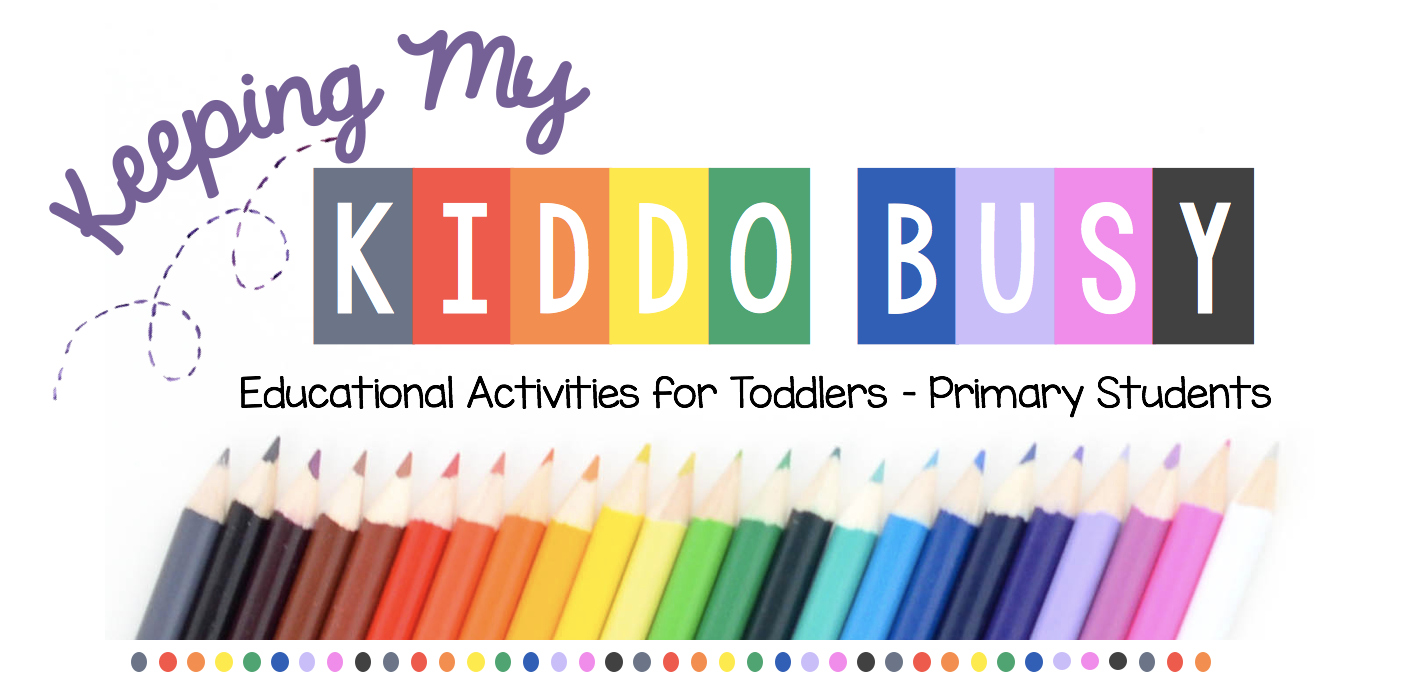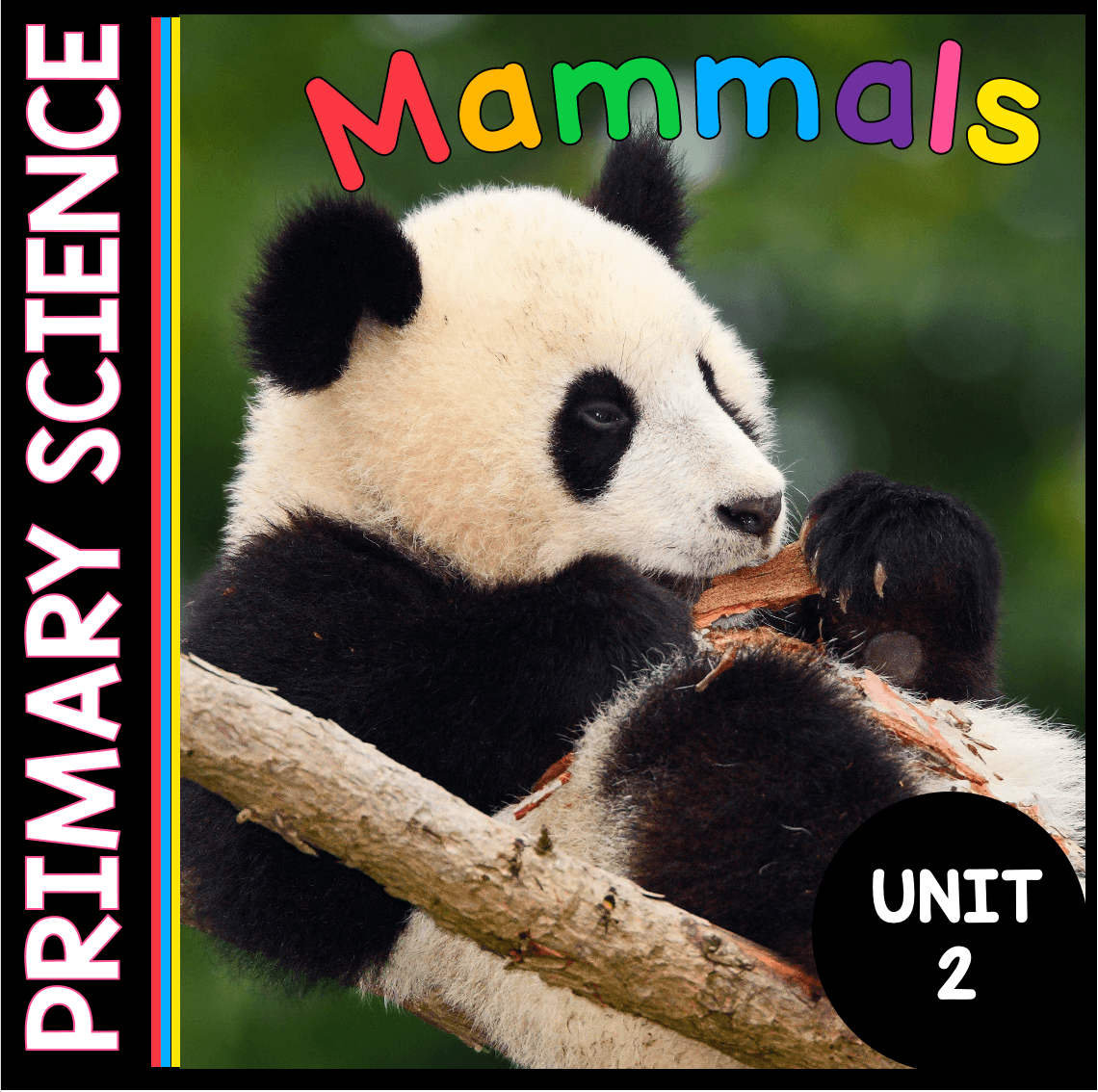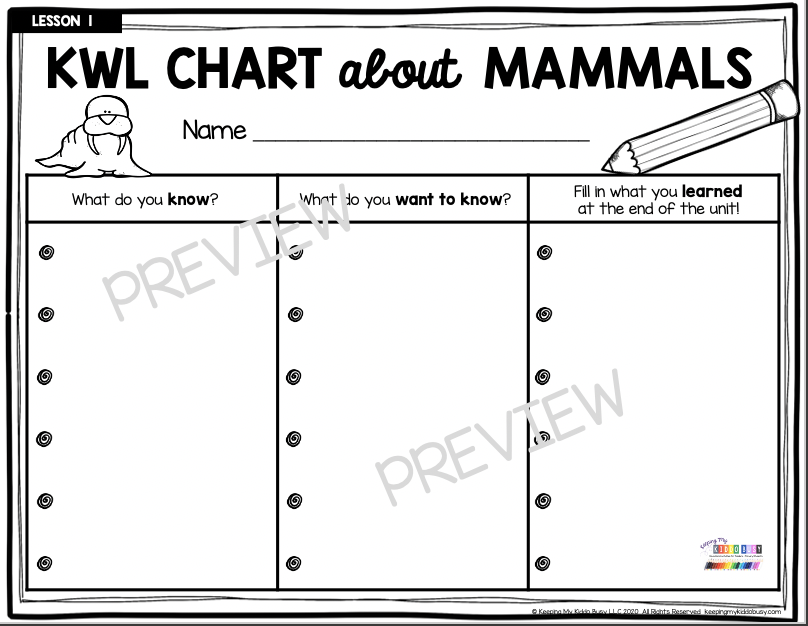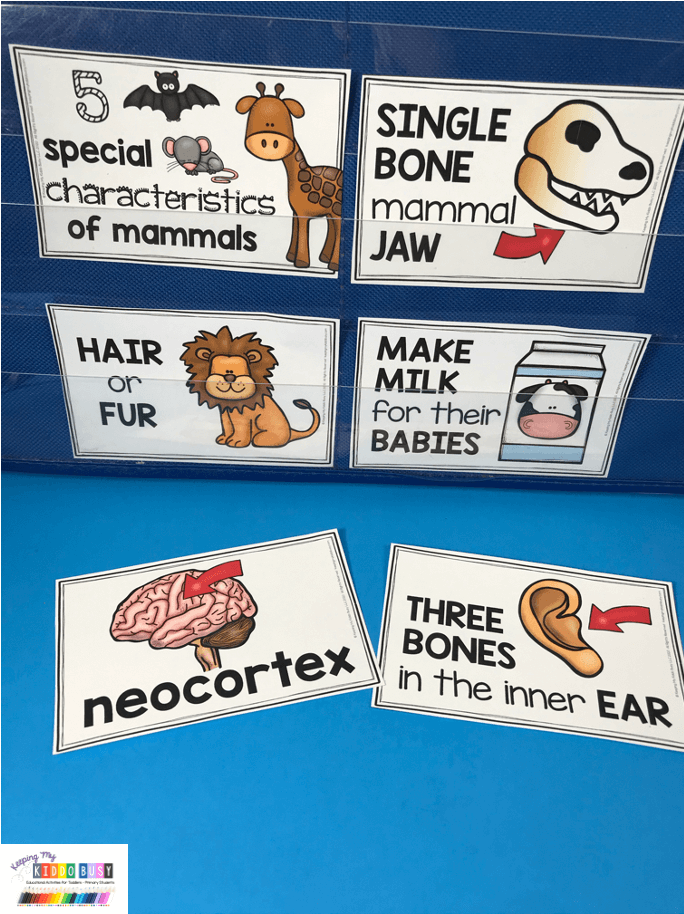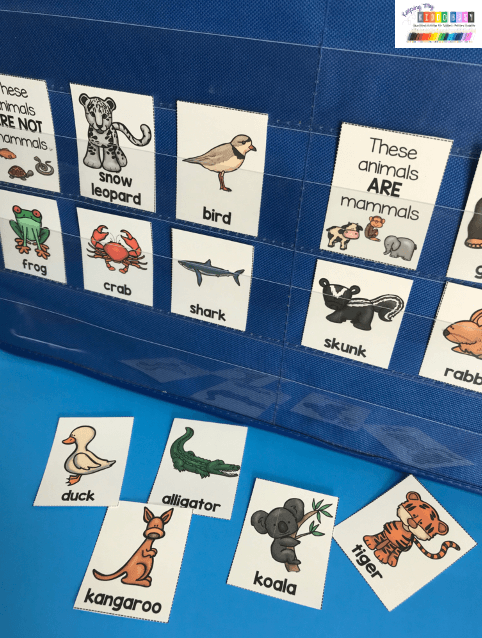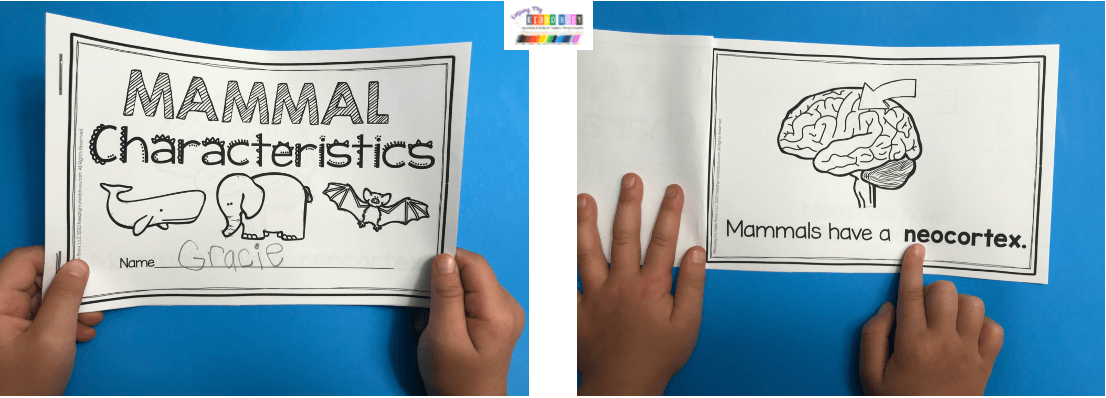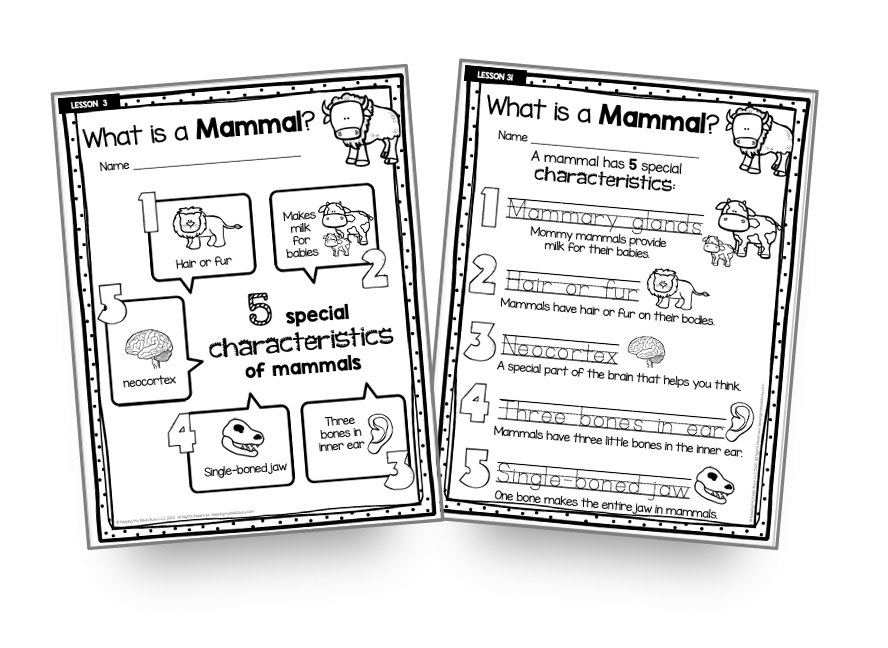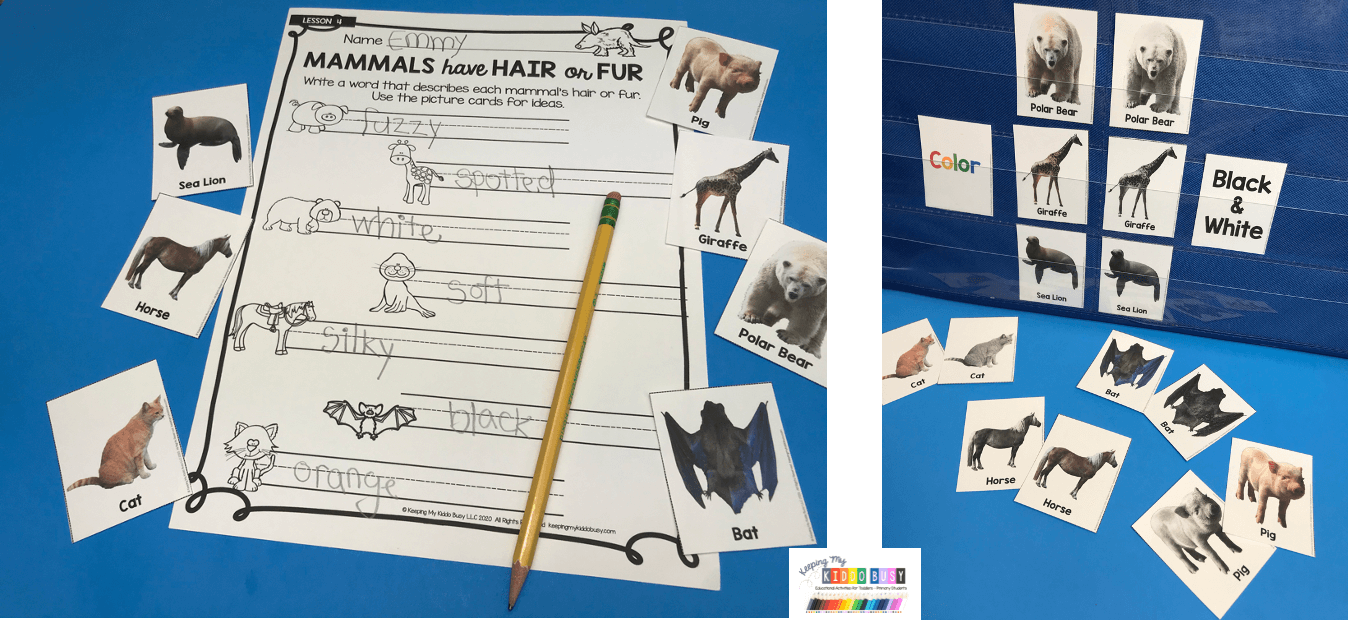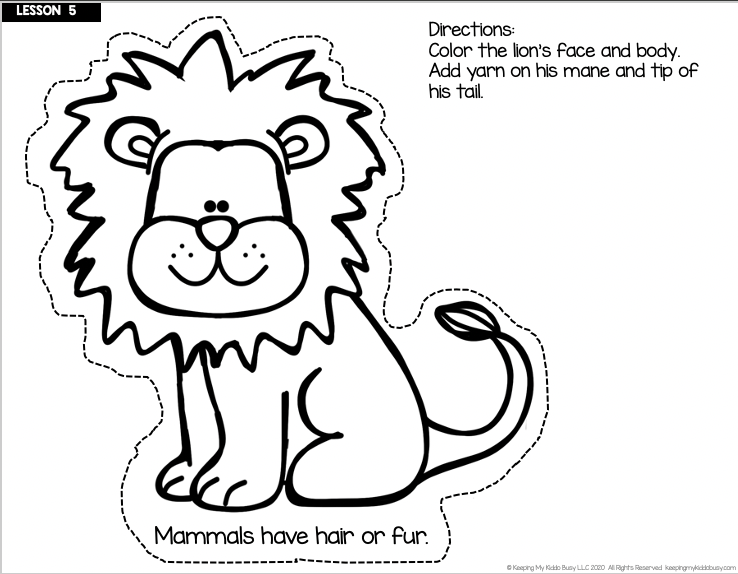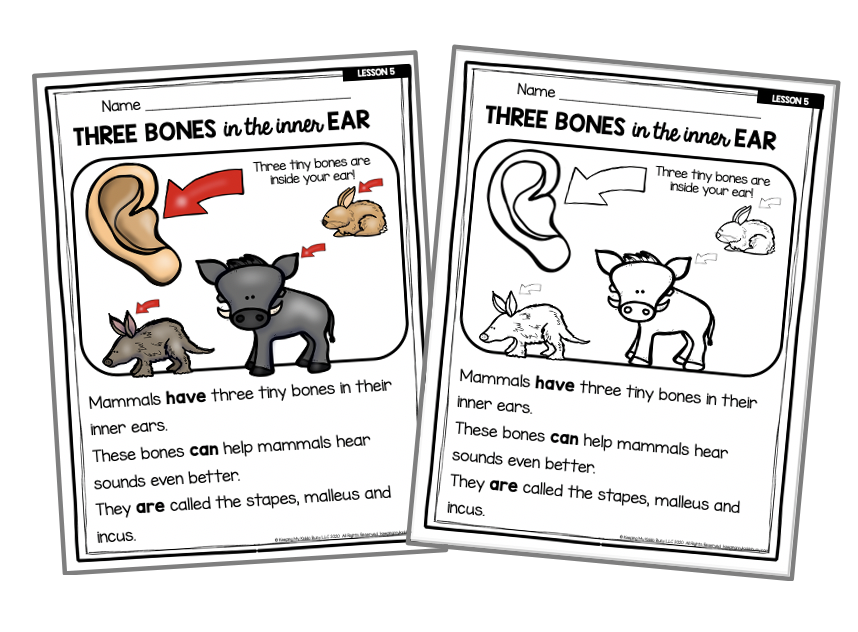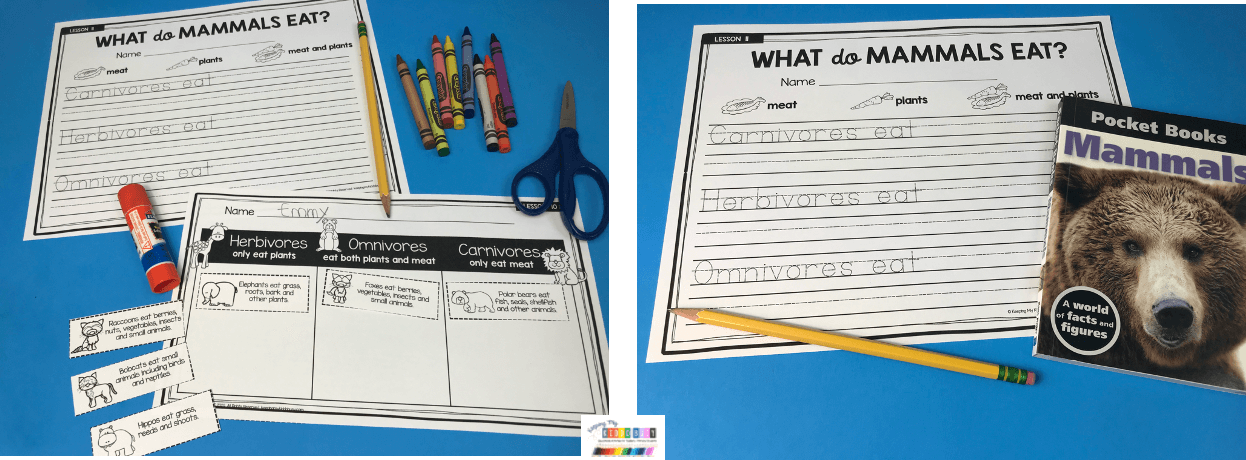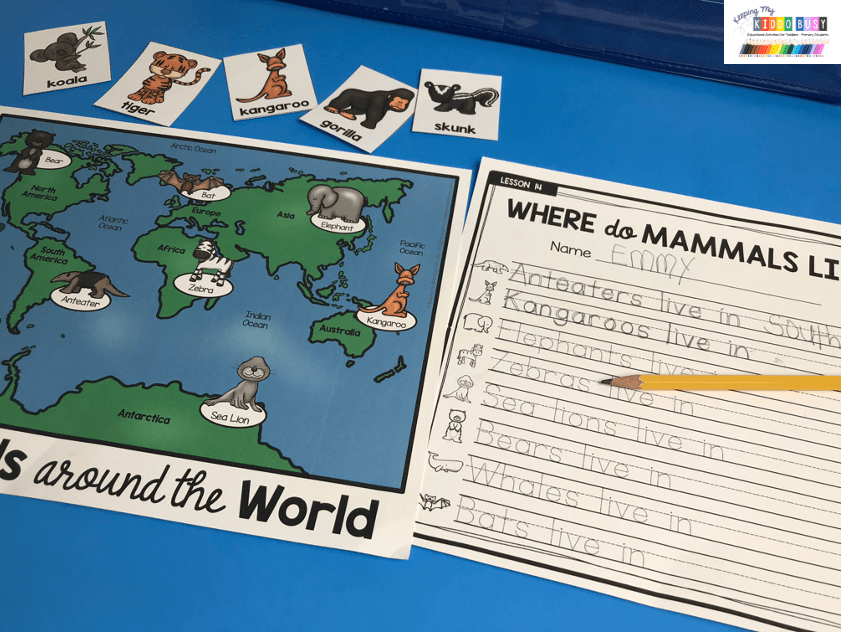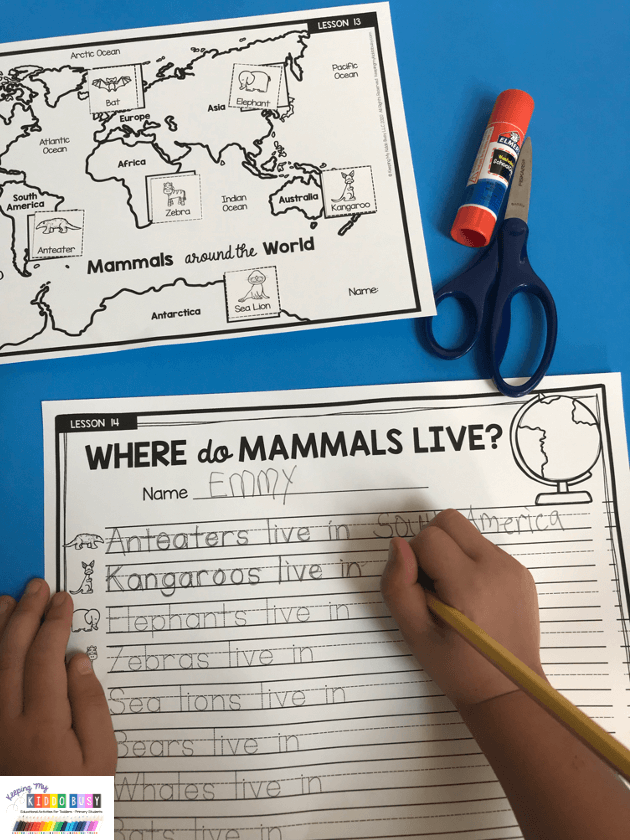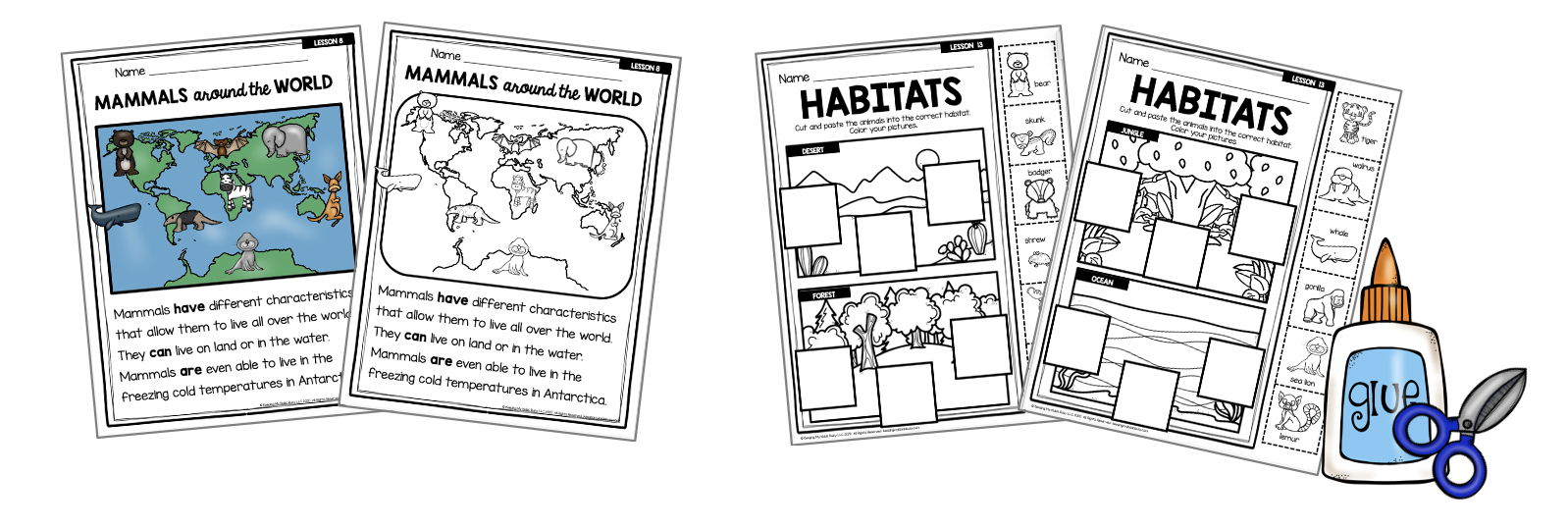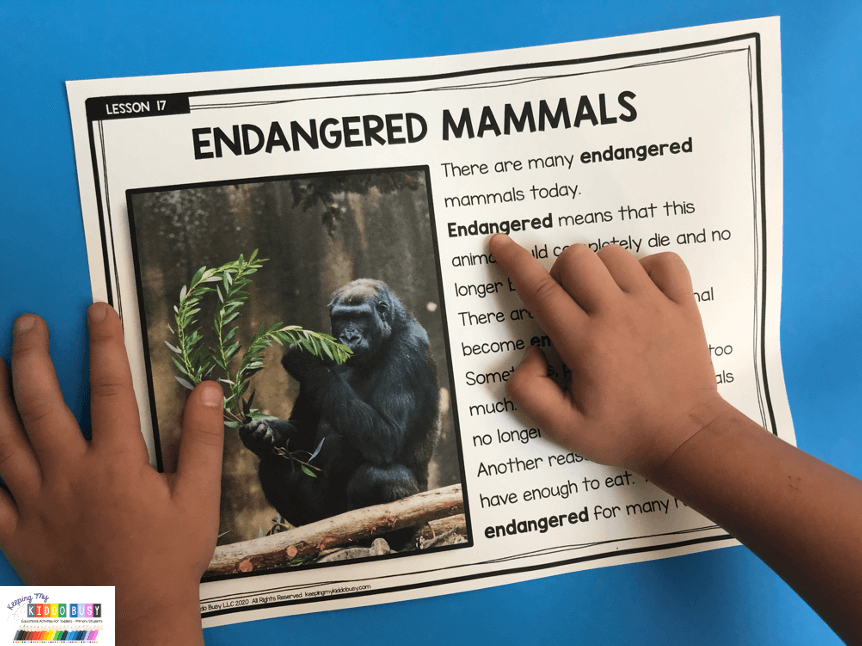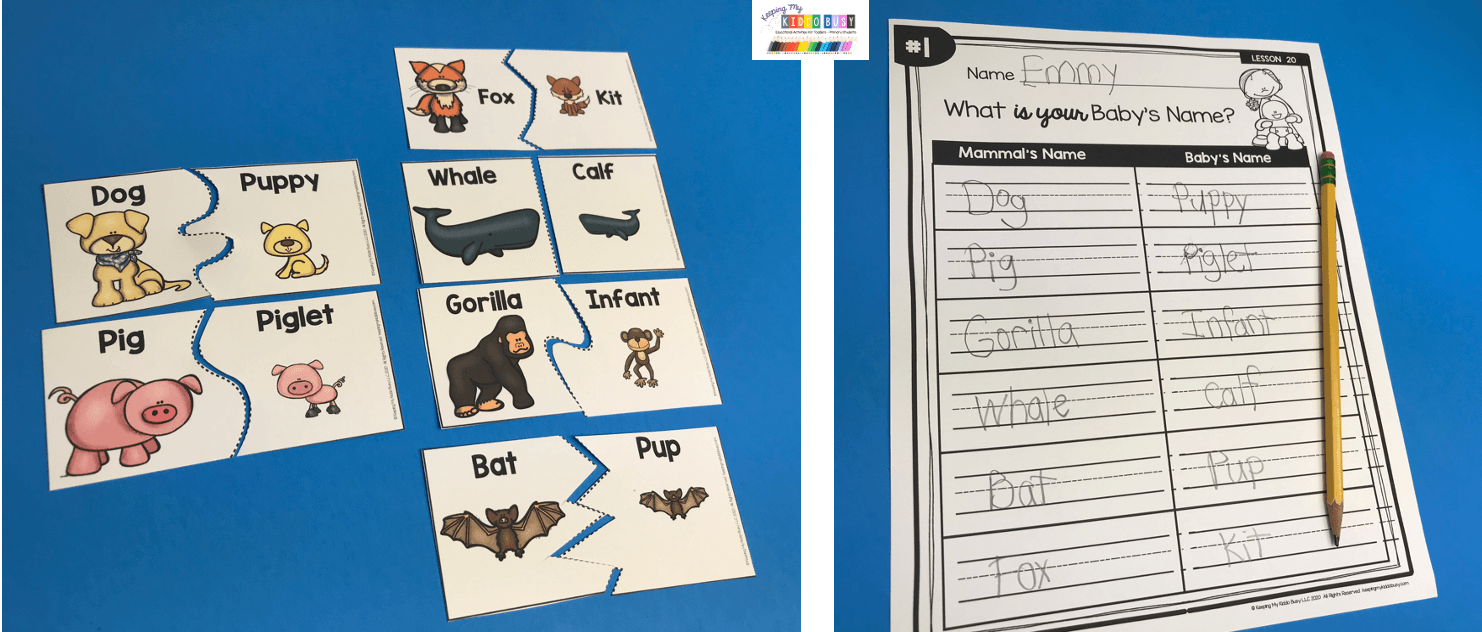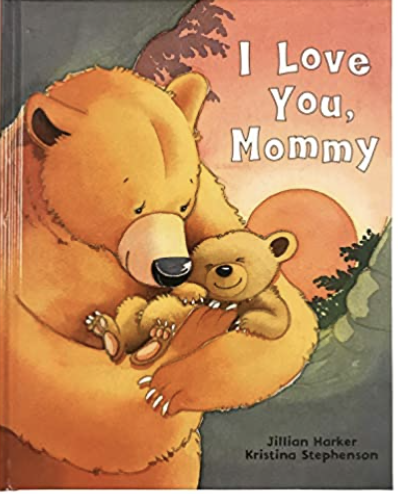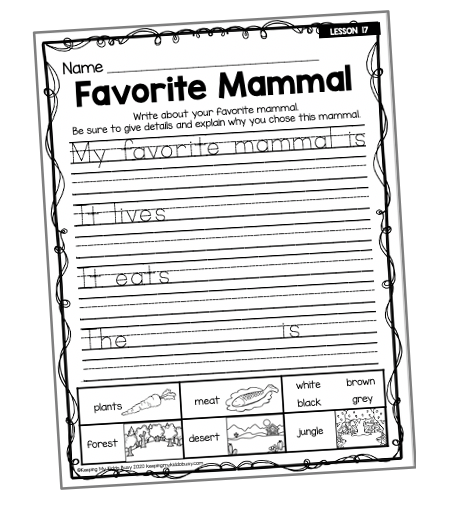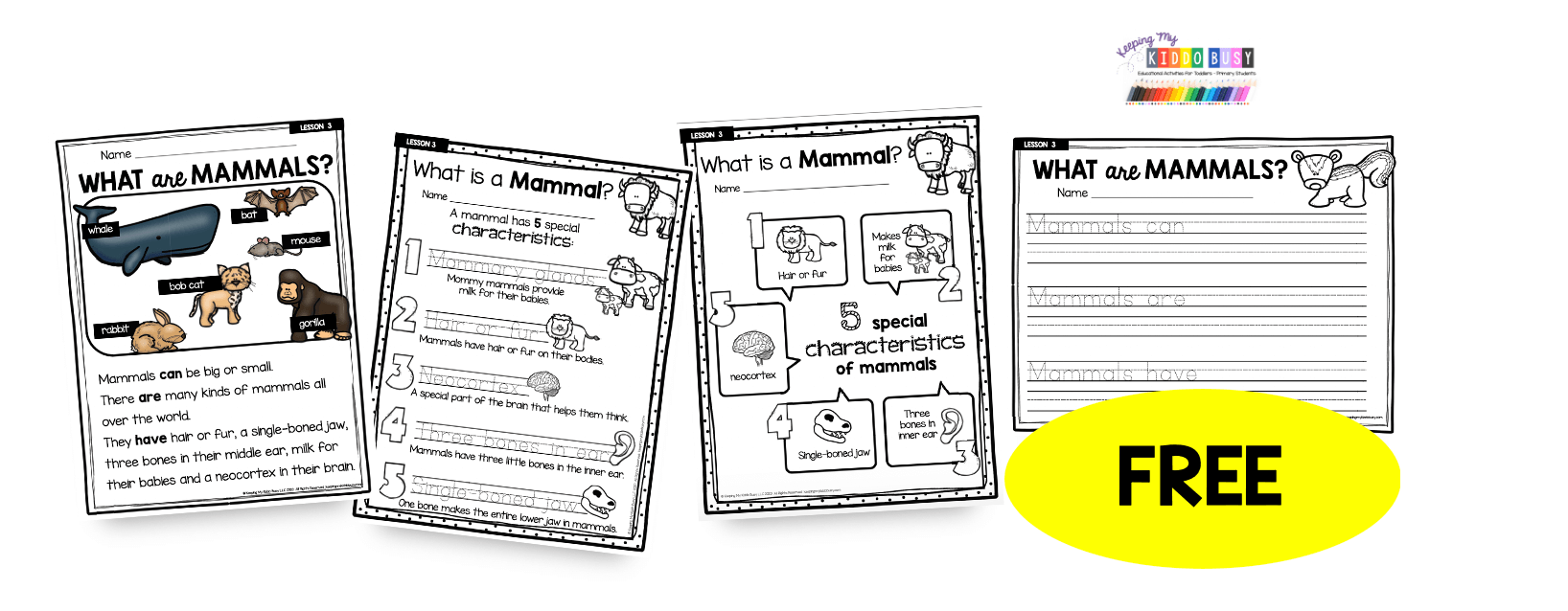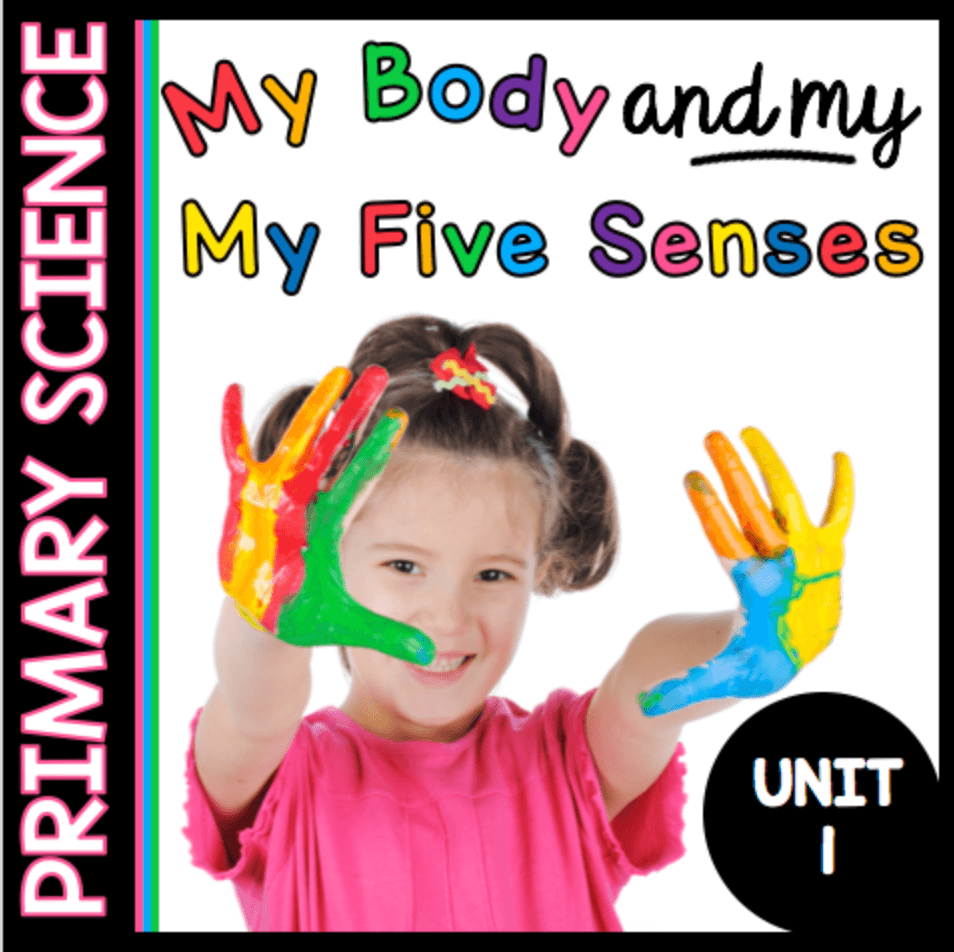Mammals Science Unit - FREE LESSON
PRIMARY SCIENCE UNIT 2 - MAMMALS
The second unit in my primary science series is finally here! We are so excited to learn all about mammals.
We had so much fun in Unit 1 - learning all about the human body and our five senses, and now we are moving on to our next science unit.
My students absolutely love learning about animals, so next up we are tackling mammals. I really had to think about what to focus on when I was creating this unit, because there is so much to teach.
I want my students to walk away understanding what makes mammals different from other animals. We also learn about their diets, habitats and how they raise their young differently than reptiles and amphibians.
I used this unit with my own children and we had a blast.
I am sharing a free lesson with you from this unit right here on this blog post. Let’s get started!
In the first lesson, I ask students what they know about mammals? Before I teach them anything, I want to share and record what they already know. We do this on our KWL chart.
If you’re teaching kindergarten, you can just fill out a class KWL chart. If you’re using this in first grade, each student can fill one in.
For homeschooling or distance learning, each child can have their own KWL. chart for their mammal folder.
After we fill in what we know (and this doesn’t have to be complete sentences - think of it as note taking), I ask my students what do they want to know about mammals?
So they might say, “How many mammals are there?” or “Where do mammals live?”
This page contains affiliate links. Read Full Disclosure
Write these questions down, and now you’re done! We fill out the last column at the very end of the unit.
Now that we have discussed what we know and want to know about mammals, it is time to get them engaged and excited about the unit!
This really isn’t hard because kids naturally want to learn about animals. I start by showing them this slideshow and reading the basic sentences. They will want to share with you the mammals they have as pets or mammals they have seen before.
This is perfect! You are building their background knowledge and they are making connections.
I show them these mammal traits posters (two print per page) and go over them briefly. Don’t worry about having them memorize these just yet - we go over them throughout the entire unit. I display them in a pocket chart for the next few weeks and refer to them often.
Then I move on to our first read aloud. I chose a super short book with kid friendly wording.
The kids love looking at the pictures in this book, and it doesn’t take long to read.
I read About Mammals. It is a great book to give children a quick overview and introduction to mammals.
If you don’t want to purchase the book, you can watch the read aloud below.
On Day 2 of this unit, I start with a quick review of what we talked about yesterday, and then we watch this quick video about mammals.
The kids love to see all the different mammals.
We review the characteristic posters from yesterday and discuss mammary glands/milk, neocortex, three bones in the inner ear, a single jawbone and having hair/fur.
Please note: having a backbone is a characteristic of mammals. However, it is not a defining feature as many animals who aren’t mammals have backbones. So we talk about this trait, but it is not included in their five special characteristics pf mammals.
I show students the animal cards, and I let them each think to themselves what their favorite animal on the cards is (if you don’t let them do this first and get it out of the way you’ll be hearing about their favorite animal for the entire lesson!)
Then we discuss the animals and the kids can help you sort them under the headings ”These animals are mammals” and “These animals are NOT mammals”.
This will lead to so many great discussions, and it will also help you identify their misunderstandings.
My third grade daughter thought feathers was essentially hair/fur, so I had to explain that it is different.
We then follow up with this cut and paste activity where students sort the animals into the two columns.
This is the perfect independent follow up to the sorting lesson we just did so you can check for understanding.
When they are done, I give them their mini book so they can start coloring their pages. Once the majority of the kids are done, we practice reading our mini book with our magic reading finger.
We get these out over the next week to practice reading and review the vocabulary.
I have the keep this in their science folder so if they finish assignments early, they can always work on coloring their mini book or rereading.
Now they we have a little background information on mammals, we get to go a little deeper in lesson three!
These materials are full of information, and they are presented in an easy to use format for younger children. The reading passages use the words “can, are, have” so children get used to these sight words. Then the writing page is organized with sentence starters using this same vocabulary so children can practice taking notes.
We review our posters and mammal cards after reading, and there are also two handouts included the five mammals characteristics for students to trace/write and color.
In lesson four, we begin to dive into each of the five characteristics. We start with learning about how mammals always have hair or fur.
We look at these beautiful real life picture cards of mammals and discuss their hair/fur. We talk about how seeing them in color gives us so much more detail about how we can describe the mammals. We sort and match them into the BW and color columns.
Then student can write an adjective on the line next to each animal that describes its fur. If you’re in the classroom, sometimes it is easier to have them use clipboards and write at the carpet with you.
Copy the graphic organizer front to back with the reading passage about mammals having fur.
Or, you can display the reading passage whole group and read it together. It also follows the can/have/are format like in previous lessons.
This next lesson is optional. We make a little craft of a lion using yarn for his hair. Just print a page for each student, they color it and add hair (pictures coming soon!)
I use this video to teach kids that although all lions may look similar on the outside, and they all have the five special mammal characteristics, mammals are also very different from each other.
There is not one way “to be a lion”, or a cat or a dog… or even a human!
I use this book/video to start a discussion on how even though all people are mammals, we are also so different. I give them the example of my two cats, and how they both have such different personalities. I remind students of our neocortex, and how that helps us think and talk, and although we are all the same in many ways, we are also all different… and this is a GOOD thing!
I just show the video above, but if you love this story and want to grab the book, it is available HERE
In lesson 6, we learn about the next mammal characteristic - mammary glands and making milk for their babies.
Here is a quick, one minute video about mammals and milk. This is a great way to show kids that all mammals drink milk- I realized most children only think of milk and cows.
The reading passages both use the can/have/are format and provide simple, straightforward information on mammary glands and milk. I start with the passage about mammals making milk, and then we get more specific with humans and milk.
The last part of the passage explains how as we get older, we begin to drink cows milk. I explain what dairy means and students then can color the pictures of the dairy items they like to eat.
To check for understanding, we then finish the lesson by doing the cut/paste activity where it asks students if a food has dairy or not. The kids make so many connections and aha moments from this lesson and it is fun to watch!
Optional extension experiment: EXPLODING MILK!
Milk has fat molecules that dish soap is attracted to. You can see the molecules attracting and binding together when you add food coloring. This is a fun, simple experiment you can do with kids that they will talk about for days!
Download the FREE experiment recording page CLICK HERE
Next, in lesson 7, we learn about the part of our brain called the neocortex. We start with our reading passage - this one comes in both color and black white. I always have them circle or highlight the words can/have/are.
This is a neat lesson, because the kids get to make a flip chart about the amazing neocortex. They cut the squares out and glue them on the matching part of the chart. These make little flaps with information. If you’re teaching kindergarten, this is just a great introduction to what your brain’s function is - if you’re teaching first or second grade, they can then quiz each other on the different things the neocortex controls.
In lesson 8, we learn about mammal’s ears.
Mammals have three distinct, tiny bones in their inner ear that no other animals have.
These little bones are called the stapes, malleus and incus.
The reading passage comes in both color and BW - and usually I read it first then we read it all together. In first grade, you could then have them buddy or whisper read. The idea is called “I do, we do, you do” and it is a great way to scaffold new reading material.
I explain how your eyes help you so much. They tell you what is going on in the world around you, and even warn you of danger (think of a fire alarm, or if you hear thunder, etc.)
We then play a really fun game! The kids love this “Guess the Sound” game.
I turn the lights off and have students close their eyes.
I play the sound and then pause it the game. You can have students whisper to a neighbor what they think the sound is, and then they raise their hand to guess. I like think, pair, and share before they raise their hands so every student has an opportunity to know what it is.
Children absolutely LOVE this game.
After we play this game, we complete the cut/paste activity shown below.
I read all the sentences first, and then they can cut, match, paste and color.
I remind them that the three tiny bones in their ear help them hear!
Lesson 9 is short and sweet and it is all about how mammals have a single boned lower jaw. Many animals have many bones that make up their lower jaw, but I have kids take their finger and run it from right under their ear, all the way around their jaw to the other ear. It is all connected as a single bone!
We read about our lower jaw bone called a dentary, and then students complete the word bank activity.
This lesson sets the stage for tomorrow when we learn about what mammals eat.
You can show this song and video at the end of lesson 9, or to start lesson 10. It is a cartoon, but the kids love the catchy tune.
The animals aren’t mammal specific, but rather it details what herbivores, carnivores and omnivores eat and animals that fall into each category.
In lesson 10 and 11, we learn about what mammals eat. I think it is fascinating that the largest land animal, an elephant, only eats plants!
These lessons provide the perfect opportunity for hands on learning too.
Bring a variety of foods to class with three plates. Label them with each type of “eater.”
For example, you could bring:
vegetables
fruit
bread and rice
lunch meat
chicken nuggets
eggs
crackers
Fill a mini cooler! Kids love choosing a food out of your cooler and then putting it on the correct plate - would an herbivore or carnivore eat this? Then at the end, say, “Okay, most of you are omnivores, so you can choose food from both plates to eat!”
Book tip: the Mammals pocketbook shown above is from Usborne. This is my new favorite way to stock my library! They truly have the best books for kids. If you go HERE and join my favorite book lady’s Facebook group and tell her I sent you, she has a great discount code for you!
The next few lessons are some of my favorite! We go around the world to see where animals live, along with specific habitats certain mammals live in.
I teach geography in these lessons, and the kids love this song.
Put anything to a tune, and your kiddos will remember it! We play this song several times a day over the next few days, and sure enough every child will be able to tell you the seven continents.
I display the colorful map shown above, and we go over the continents.
Then students get the black and white version. There are two differentiated versions included - one where they match the animals and one where the do it on their own. Use one or both!
Tip: I make sure to tell them that any of these mammals live on more than one continent. I start with the ones that I know have to live in specific places - for examples, kangaroos only live in Australia. Zebras only live in the wild in Africa, which means the elephant must be in Asia, etc.
Then, we follow up with the writing activity. The lessons are scaffolded for you. I love that we are tying in science, geography, reading and writing. We are learning so much!
I bought three of these mini books, and my kids absolutely love looking through them. There are colorful pictures of so many mammals and interesting facts about where the live, what threat, what they can do, etc.
The pictures are great for pre-readers, and my own children who are older (7 and 9) have memorized so many of the facts… they have read them so many times.
At the time I am positing this, they are only $5, and you can grab them HERE
Now that we are learning about where mammals live around the world, we get a little more specific with habitats. Do camels and polar bears like to live in the same area? No!
Different mammals have adaptations that help them live in different habitats and climates.
We study four specific habitats in this unit: deserts, forests, oceans and jungles.
You can laminate and cut out the mammals, and kids can place them in the different habitats.
This is an excellent opportunity to discuss how you can find some of the mammals in multiple habitats, whereas some mammals only live in very specific places.
I break the lessons does by focusing on deserts and forests on one day and then oceans and jungles on another day. They sort the cut out laminated mammals on the colorful mats, and then they do the cut/paste activity to check for understanding.
The next day we do the other two habitats with the same format.
They are practicing so many skills and I love how hands-on this lesson is. The kids love placing the mammals in their habitats.
Our next lesson focuses on endangered mammals.
I start by asking students if the know the word endangered? I show them that the root word of danger and.we discuss what this means.
I then read the passage to them and then you can read it together too.
I ask them why mammals are endangered we we have a discussion on this.
We then fill out our graphic organizer. You can print that front to back with the sentence starters as well.
Depending on how students are doing, you can do both of these in the same day or break it up over two days. These two activities solidify information for students and it is a great way to check for understanding.
It is the perfect way to build background before we do the next hands-on activity. Two main reasons animal become extinct besides over hunting is loss of habitat and not enough to eat. This next activity shows students what this actually means.
The grey wolf lives in the forest and it has been losing its habitat.
When humans continue to cut down the forest they live in, the wolves run out of room to live and hunt.
There are eight little wolves, but only five have room in the habitat. This visual shows students that when there isn’t enough room for all the wolves to live, the wolves can’t be in their habitat to survive.
The Indochinese tiger is endangered, and one reason is there isn’t enough for them to eat. There are four tigers, but only three warthogs for them to hunt. What happens to the tiger that doesn’t get to eat?
This will lead to higher level thinking discussions, and students can see for themselves why these mammals are endangered.
If you didn’t finish the writing activity about endangered mammals from the last lesson, you can finish that with this lesson.
Lesson 19 moves on to teaching students that they are mammals too! We have touched on this in previous lessons, but humans are the main focus of lesson 19.
I would start by showing this informative video. It is a great review of what we have learned so far.
These are the materials I use in the lesson, but you can use the ones you need.
The reading passage teaches children they are mammals! The reading material is the same, but one has a real life color photo and one is black and white. Then, children can fill in information in the graphic organizer and make a craft (photo coming soon!)
In lesson 20, we learn about how mammals take care of their young.
This short reading passage gives an overview of how mammals care for their young. Other species sometimes don’t even stay close by when their babies are born!
Mammals are different as they nurture, feed and teach their babies.
The kids love this lesson because they love learning about baby animals. This is fun to teach - a lot of kids know a couple, but not most of the baby animal names. There are 12 self-correcting puzzles and coordinating recording pages.
You can do these whole group, in all groups or make each kiddo their own set.
I the next lesson, we go a little deeper with how parents take care of their babies (note: if this is a sensitive topic to many children in your class, you can skip this lesson.)
This is the absolute perfect book to introduce lesson 21 - how parents take care of their babies.
It is an adorable story about mama bear takes care of, nurtures, teaches and loves baby bear.
You can grab it HERE or you can play it on YouTube for your children below.
This book gave us the perfect introduction to parents caring for their babies. Now we get to discuss, dive deeper and write.
I provide a picture word bank and writing paper, and we discuss all the ways parents take care of their children. I lead a whole group discussion and take notes to make a chart.
Your kiddos will share all sorts of funny things like, “Take me to McDonalds!” or “Drive me to my friend’s house!”
Once we have shared and discussed, I help them with a sentence starter.
Every child has a very different living situation, so we have to be careful with how we provide structure and scaffolding.
They can even say grandma, grandpa, auntie or uncle. It doesn’t have to be a parent who cares for them.
We are getting ready to wrap up the unit, and a great way to do this is to compare and contrast some of the mammals we have learned about.
This is an excellent higher-level comprehension task.
You can simply cut out the text that is color coded, and students can place the information on the correct part of the graphic organizer.
I spread this across two lessons (one set each day) and we compare horses and pigs, and polar bears and sea lions.
I love to see their little brains working hard to process and sort the information where it belongs.
To wrap up our mammals unit, we play a matching game and write about our favorite mammal.
There are so many games you can play with these picture cards, but we love memory and “go fish”.
Just print 2-4 sets of each page, laminate and cut apart.
Kids love to play with these cards!
In our last lesson, we write about our favorite mammal. Students have learned so much in this unit!
The picture word bank provides ideas and scaffolding for students, and the sentence starters make it feel much less overwhelming.
This is a great way to finish the unit, and after we write, the kids love to share their pieces.
Sometimes, the mammal they choose surprises me, so I love this lesson!
Ready to get started with the second unit in our primary science series?
“Extremely well thought out and engaging for students! Looking forward to the next science units - I will purchase more. Well worth the investment”
“I absolutely love every product she makes. Please keep making more science units! This one is packed with excellent information and is written in a way that keeps my students attention and interested in learning! Thank you!”
“These science units have been wonderful for the pod teaching I am doing with kindergarten students. I can't wait for the plant one!”
CLICK HERE TO VISIT OUR PRIMARY SCIENCE HOMEPAGE
Have you taught Unit 1 - My Body and my Five Senses yet?
“This resource is so comprehensive and well put together! My daughter has loved doing the activities and learning at the same time!”
“I love the real images, it makes it easier for my students to understand the topics. I would love to have all the other units too! Thanks!”
“I was looking for a hands-on study of the human body for my kindergarten students. This unit fit the bill and saved me the hours of time that it would have taken to create my own study. It was easily adapted to fit my time restraints and my students' abilities. Thanks, Keeping My Kinders Busy. I wish your other science units were available for purchase.”
